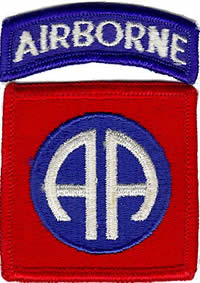82nd Airborne Division
History (page 2/2)
The shoulder patch of the 82nd Airborne Division, two white letters “AA” (for “All Americans”) on a blue circle in a red square.
![]() Battle order of the 82nd Airborne Division on D-Day
Battle order of the 82nd Airborne Division on D-Day
Operation Market Garden
General Montgomery has drawn up a plan that requires far more allied air regiments than in June 1944, during Operation Overlord. This plan of attack, called Operation “Market Garden”, consists of a large airborne and ground offensive in Holland, which will allow the Allies to capture bridges on the Rhine.
The 82nd is then placed under the British command of the 2nd Army, also regrouping the 101st US Airborne Division and the 1st British Airborne Division. Before the operation, the 504th PIR, which had not participated in Operation Overlord, joined the 82nd Division while the 507th was withdrawn.
On September 17, Market Garden is launched: 20,000 allied paratroopers jump into the Dutch sky. The German anti-aircraft artillery is absent and parachutes are particularly successful. But as in Normandy, gliders suffer a lot of landing losses, both in human lives and in material.
The 82nd is responsible for seizing 16 bridges on two rivers: Maas and Waal. It must also maintain the road linking the towns of Nimeguen and Groesbeek. Its losses are very high: Company C of the 504 PIR loses nearly 50% of its forces by attacking the bridge of Grave over the River Wall. But the Americans are showing courage in every way: on 21 September, Soldier John Towle, company C of the 504 PIR, retains a German attack consisting of nearly 100 soldiers and 2 tanks (he receives the Medal of the US Congress, the Medal of Honor). But after 56 days of fierce fighting against a formidable enemy, the Allies are forced to retreat. Market Garden is a failure.
Replaced on November 11, 1944, the 82nd Airborne is having a (short) break in the city of Reims in France.
Battle of the Bulge
When the Germans launched their last major offensive in the Ardennes on December 16, 1944, the Allies were disoriented. Their last reserves are the two US airborne divisions of D-Day, the 82nd and 101st divisions. Two days later, on December 18, the 82nd met in the town of Webermont in Belgium and took position along the Salm river.
The fighting was extremely trying, but the German forces were stopped. The victory was then at hand.
Germany
Replaced in the Ardennes at the beginning of 1945, the 82nd crossed the Rhine and passed the Siegfried Line in Germany and on April 30, 1945, it carried out its last operation of the Second World War crossing the river Elbe near the city of Bleckede.
On 2 May 1945, the 82nd Airborne Division discovered and released the survivors of the concentration camp in Woebbelin. On the same day General Gavin accepted the surrender of nearly 150,000 soldiers of the 21st German Army.
On May 8, 1945, the war stopped in Europe. The 82nd Airborne Division had spent 442 days fighting.
Since 1945
The 82nd participated in many military operations after the Second World War, such as the Power Pack operation in the Caribbean in April 1965, the Vietnam War between 1968 and 1969, during Operation Urgent Fury on the island of Grenada in 1983.
The 82nd Airborne paras also served in 1988 as part of Operation Golden Pheasant in 1989 when the Panama Airport (Operation Just Cause) was captured in 1991 during Operation Desert Storm from 2002 in Afghanistan as part of Operation Enduring Freedom and in Iraq from 2003.




